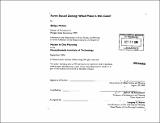| dc.contributor.advisor | John P. de Monchaux. | en_US |
| dc.contributor.author | Mehta, Shilpa, M.C.P. Massachusetts Institute of Technology | en_US |
| dc.contributor.other | Massachusetts Institute of Technology. Dept. of Urban Studies and Planning. | en_US |
| dc.date.accessioned | 2007-07-18T12:59:21Z | |
| dc.date.available | 2007-07-18T12:59:21Z | |
| dc.date.issued | 2006 | en_US |
| dc.identifier.uri | http://hdl.handle.net/1721.1/37865 | |
| dc.description | Thesis (M.C.P.)--Massachusetts Institute of Technology, Dept. of Urban Studies and Planning, 2006. | en_US |
| dc.description | "September 2006." | en_US |
| dc.description | Includes bibliographical references (p. 97-102). | en_US |
| dc.description.abstract | Form-based zoning is a relatively recent innovation in zoning reform. Many cities in the U.S. have adopted form-based codes in lieu of or as a supplement to conventional zoning and many more are in the process of studying and legislating this alternative. Form-based codes focus on the physical form of the built environment by prescribing parameters for physical form representing a specific intent for the public realm. Typically, form-based codes consist of regulating plan(s), urban standards (building envelope standards and streetscape/thoroughfare standards), and architectural standards. This thesis questions if the 'product' of form-based codes, i.e. the place imagined as a consequence of form-based codes, is differentiable based on place character. Place character refers to certain physical qualities based on location (loci) as well as certain perceptual qualities based on the life in these spaces (genius). This thesis hypothesizes that form-based could certainly result in quality urban spaces but the essential character of these spaces could be singular and indistinguishable from place to place. In order to examine this proposition, this thesis follows the terrain of a representative sample of form-based codes, which are studied as a proxy for the places that are intended as a consequence of implementation. | en_US |
| dc.description.abstract | (cont.) The narrative for each code, which could be described as a specific interaction between the conceptual framework of the code and the contextual framework of a place, is dissected along specific cross-sections, such as geography, chronology, scale/structure, intent, typology, and fit. In addition, qualitative correlations across cross-sections were used to explain patterns observed in the cross-sections.A secondary question posed by this thesis examines the impact of factors peripheral to the code, such as the place itself, the process, the people involved, and the policy framework, on this lack of differentiation based on place character. This thesis concludes that form-based codes, as a conceptual framework, possess the structure and flexibility to be responsive to a place-based contextual framework. The lack of place character is a consequence of the limited narratives that define the intent of the code with respect to place and classify the code typologically.This is partially influenced by the current association of form-based codes with New Urbanism. In addition, this lack of differentiation based on place character is not necessarily endemic to the code itself but a consequence of factors peripheral to the code, i.e. processes that precede the code and/or processes that follow the code. | en_US |
| dc.description.statementofresponsibility | by Shilpa Mehta. | en_US |
| dc.format.extent | 102 p. | en_US |
| dc.language.iso | eng | en_US |
| dc.publisher | Massachusetts Institute of Technology | en_US |
| dc.rights | M.I.T. theses are protected by copyright. They may be viewed from this source for any purpose, but reproduction or distribution in any format is prohibited without written permission. See provided URL for inquiries about permission. | en_US |
| dc.rights.uri | http://dspace.mit.edu/handle/1721.1/7582 | |
| dc.subject | Urban Studies and Planning. | en_US |
| dc.title | Form-based zoning : what place is this code? | en_US |
| dc.type | Thesis | en_US |
| dc.description.degree | M.C.P. | en_US |
| dc.contributor.department | Massachusetts Institute of Technology. Department of Urban Studies and Planning | |
| dc.identifier.oclc | 124052028 | en_US |
